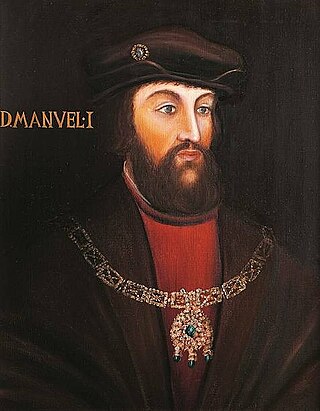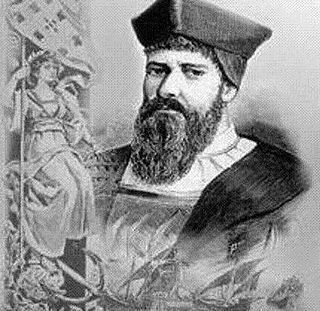| |||||
| Centuries: | |||||
|---|---|---|---|---|---|
| Decades: | |||||
| See also: | List of years in Portugal | ||||
Events in the year 1515 in Portugal .
| |||||
| Centuries: | |||||
|---|---|---|---|---|---|
| Decades: | |||||
| See also: | List of years in Portugal | ||||
Events in the year 1515 in Portugal .

Afonso de Albuquerque, 1st Duke of Goa, was a Portuguese general, admiral, and statesman. He served as viceroy of Portuguese India from 1509 to 1515, during which he expanded Portuguese influence across the Indian Ocean and built a reputation as a fierce and skilled military commander.

Manuel I, known as the Fortunate, was King of Portugal from 1495 to 1521. A member of the House of Aviz, Manuel was Duke of Beja and Viseu prior to succeeding his cousin, John II of Portugal, as monarch. Manuel ruled over a period of intensive expansion of the Portuguese Empire owing to the numerous Portuguese discoveries made during his reign. His sponsorship of Vasco da Gama led to the Portuguese discovery of the sea route to India in 1498, resulting in the creation of the Portuguese India Armadas, which guaranteed Portugal's monopoly on the spice trade. Manuel began the Portuguese colonization of the Americas and Portuguese India, and oversaw the establishment of a vast trade empire across Africa and Asia.

The title Duke of Braganza in the House of Braganza is one of the most important titles in the peerage of Portugal. Starting in 1640, when the House of Braganza acceded to the throne of Portugal, the male heir of the Portuguese Crown were known as Duke of Braganza, along with their style Prince of Beira or Prince of Brazil. The tradition of the heir to the throne being titled Duke of Braganza was revived by various pretenders after the establishment of the Portuguese Republic on 5 October 1910 to signify their claims to the throne.

João da Nova was a Galician-born explorer in the service of Portugal. He is credited as the discoverer of Ascension and Saint Helena islands.

St. Angelo Fort is a fort facing the Arabian Sea, situated 3 km from Canannore (Kannur), a city in Kerala state, south India.

The Military Order of Saint James of the Sword is a Portuguese order of chivalry. Its full name is the Ancient, Most Noble and Enlightened Military Order of Saint James of the Sword, of the Scientific, Literary and Artistic Merit.

Lopo Soares de Albergaria was the fifth captain-major of the Portuguese Gold Coast and third governor of Portuguese India, having reached India in 1515 to succeed Afonso de Albuquerque as governor.

Afonso de Albuquerque Square is a public square in the Belém district of the city of Lisbon, Portugal.
Events from the year 1509 in India.
Manuel of Menezes was the second son of Pedro de Menezes 5th Marquis of Vila Real and of his wife, Beatrice of Lara.

The Portuguese conquest of Hormuz in 1507 occurred when the Portuguese Afonso de Albuquerque attacked Hormuz Island to establish the Fortress of Hormuz. This conquest gave the Portuguese full control of the trade between India and Europe passing through the Persian Gulf.

The Portuguese conquest of Goa occurred when the governor Afonso de Albuquerque captured the city in 1510 from the Adil Shahis. Goa became the capital of the Portuguese State of India which included possessions such as Fort Manuel, the territory of Bom Bahia, Daman and Chaul. It was not among the places Albuquerque was supposed to conquer. He did so after he was offered the support and guidance of Timoji and his troops. Albuquerque had been given orders by Manuel I of Portugal to capture Ormus, Aden and Malacca only. Goa would remain under Portuguese control until 1961.

The title Duke of Goa was the first Portuguese ducal title given outside the royal family, and the first Portuguese noble title to be granted to a territory overseas, Goa, India.

Fernão Gomes de Lemos was the third and last Captain of Portuguese Ceylon. Lemos succeeded Lopo de Brito and was appointed in 1522 under John III of Portugal, he was Captain until 1524. In 1524 when he left as Captain, the office was left vacant until 1551, where the office was succeeded by Captain-majors of Portuguese Ceylon. He was also Portuguese Ambassador to Persia, appointed by Afonso de Albuquerque in 1515.
Events from the year 1515 in India.

Dom António de Ataíde, 1st count of Castanheira, was a childhood friend and favorite of King John III of Portugal. As an advisor to the King, he played a key role in Portugal's policies towards its colony of Brazil. He also served as a diplomat in missions to several European countries and was a Minister and member of the King's council.
Events in the year 1890 in Portugal. There were 951,000 registered voters in the country.
Events in the year 1886 in Portugal.
Events in the year 1815 in Portugal.